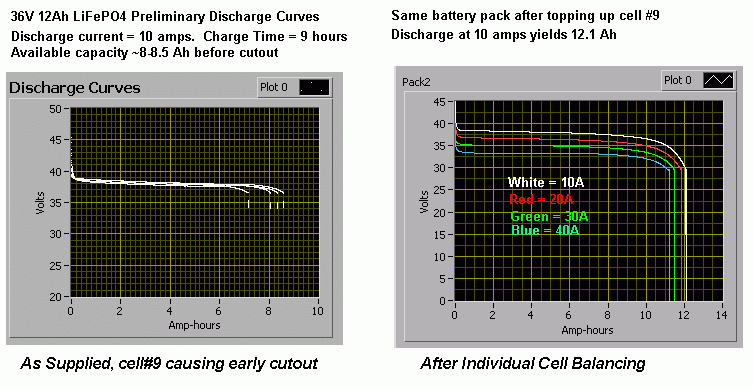Lithium Iron Phosphate Situation
As mentioned in the last web update, we did receive the shipment of 4C rated LiFePO4 battery packs. However, we have not put them up for sale yet because our testing has shown a few issues that we wanted to resolve. For those who don't care about juicy battery details, feel free to skip the next few paragraphs
--------------Lots of Tech Content Below----------------
Last year we sampled a number of LiFePO4 battery manufacturers looking to find one that delivered appreciable discharge currents yet also came in a finished looking and robust package. The one that we settled with not only met these requirements, it also came with a fairly advanced switched capacitor cell-balancing battery management system (BMS). This BMS did cell balancing splendidly, but it had the defect that it would continue to bleed a small amount of current from the cells even after the pack was flat and the BMS had cutout. If the battery was drained flat and then stored for several months, the BMS itself could actually end up discharging the cells all the way to zero volts and causing permanent damage.
These were at our request replaced with a new BMS circuit that would have virtually no quiescent current, causing some of the original delays to the shipment. As a downside though, it turns out that the rate of cell balancing with this new BMS is many orders of magnitude less than with the prior circuit. When we began testing the packs from this shipment we were typically only getting between 10 to 11.5 amp-hours out of them, due to the cells not being balanced. By opening up the packs and individually discharging those cells that are more charged than the rest of the pack, and topping up those cells that are running low, we've been able in almost every case to restore a full 12 amp-hours of available capacity. The images below shows a case in point.

The original pack as we received it was only delivering 8 amp-hours. You can see that there is not a very pronounced roll-off in the cell voltage before it shuts off, indicating that it was just 1 or 2 cells at a low state of charge causing the BMS to cutout. After opening the pack up we identified a single cell that was low, charged it up independently from the others in the pack, and afterwards it tested out perfectly. Most of the time it isn't so simple, and there are several cells both low and high that need to be adjusted and a few testing iterations before the capacity to reaches 12Ah.
So what next?
We have been going through all the batteries one by one in this manner and ensuring that each pack is balanced and delivers its rated capacity, and then re-sealing them. However, we still have some reservation about selling these until we are confident that the cells won't gradually go out of balance again in your hands. Ideally the amount of cell balancing by the BMS at the end of the charge cycle is sufficient to counter any natural deviations in cell leakage currents and BMS sense currents, and then this will be so. There are naturally a lot of tests going on at our end and a lot of back and forth with the manufacturer to get to the bottom of it, and we may decide in the end to replace the BMS circuits across the board
--------------- End of Heavy Tech Content ----------------------
Can I buy one?
The answer is yes, but only if you read the above paragraphs and fully understand and accept the implications. There is a small but finite possibility that the battery over time might go out of balance resulting in a reduced usable capacity, and you may have to open up and either service individual cells or replace the BMS circuit down the road if this is the case. We have a slow but steady stream of 24V, 36V, and 48V packs that are coming off the end of the testing/balancing cycle.
Update Apr 14th - Our final testing of the BMS shows that it does do cell balancing at an acceptable rate at the end of the charge cycle, and packs that are out of balance do slowly get better each time the packs is used and then recharged. The only situation we can forsee where the batteries could drift out of balance again is if they are stored for prolonged periods of time without use.


 Canadian
Canadian


